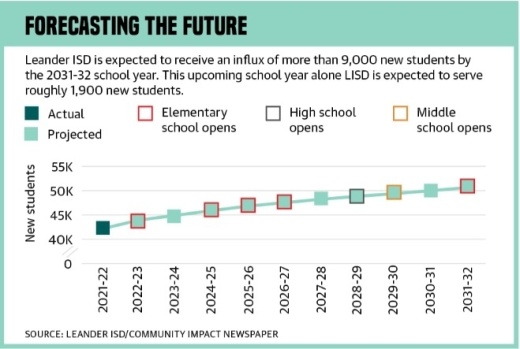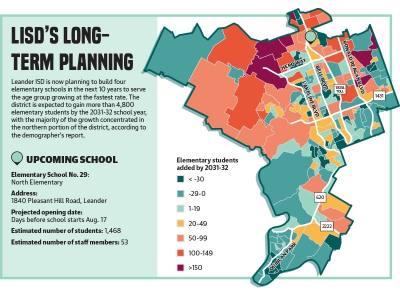LISD has its focus set on opening North Elementary School in the Bryson community and developing a long-range facilities plan to prepare the district for future growth. To that end, the district formed the Long Range Planning Committee, whose primary goal is to develop a 10-year facilities plan that takes into account population changes over time, facility optimization and fiscal responsibility.
This committee was formed after two out of three of the bond propositions in the November election failed. One of the failed propositions was heavily focused on the construction of new schools and facilities and renovating existing ones to better accommodate LISD’s steady growth.
“Fortunately, we’ve been very tight with the money—we always are—because it doesn’t grow on trees,” Chief Facilities Officer Jimmy Disler said. “So we want to make sure it’s used for the facilities when we need them and not just go spend the money because it’s there.”
No bond, new plan
Proposition A of LISD’s November bond package included the design and construction of three elementary schools and one middle school as well as the construction of one additional elementary school, whose design was included in the 2017 bond.
Last year, Community Impact Newspaper reported LISD prepared to open eight new schools, six of them being elementary schools, by 2026 to meet growth needs.
However, after the committee’s six-month planning period this year, the district now plans to open six new schools over a 10-year period. The new plan includes four elementary schools, one middle school and one high school.
This new plan also caused a few school openings to be delayed. The district announced plans to open Middle School No. 10 in 2024-25 or 2025-26, but since the bond package failed, the date was pushed back to 2029-30 in the most recent Long Range Planning Committee report.
Still, growth in LISD continues. The district’s demographer report includes low-, moderate- and high-growth scenarios that show the district could add between roughly 3,600 and 13,700 students in the next 10 years. The moderate-growth scenario indicates about 9,000 more students by 2031, including roughly 1,900 more students this school year. Disler said the majority of this growth will be located in the north and northwest parts of the district.
According to the report, more than 800 elementary students will be added to each of the Bagdad, Tarvin and Mason attendance zones and more than 500 will be added to the Larkspur and Plain elementary attendance zones in the next 10 years.
“The growth doesn’t happen everywhere; it is happening in the north part of our district, where the central and southern part of the district is declining enrollment, which has caused underutilized facilities,” Disler said.
North Elementary, the district’s 29th elementary school, will open days before school starts for the 2022-23 year. Located in the north portion of the district, North aims to relieve capacity constraints at Larkspur and Plain elementary schools.
The district’s Bond Oversight Committee also recommended starting construction of Elementary School No. 30, which will be funded by savings from previous bonds. ES 30 will be located in the northwest part of the district, and it is intended to provide capacity relief at Akin and Rutledge elementary schools.
In the meantime, district staff have shifted their focus to building portables for campuses that have reached functional capacity.
Chief Financial Officer Elaine Cogburn said there will be about 15 portables across the district. Moving, leasing and outfitting these portables will cost the district about $1 million.
Campuses receiving portables include Larkspur Elementary, Danielson Middle and Glenn High schools, all located mainly in the northern sector of LISD.
“Because we failed the bond in November, some of our projects have been put on hold, or are on a different schedule now, and so we are starting to have campuses that are going to see more students than their functional capacity can hold,” Superintendent Bruce Gearing said.
Optimizing existing facilities
With most of the growth being in the northern portion of the district, there has been some discussion on rezoning campuses and efficiently using existing facilities to allow relief in the north.
Typically, rezoning occurs when a new school opens. However, the Long Range Planning Committee has recommended additional rezoning to relieve congested campuses and utilize existing facilities to the fullest extent, according to district documents.
Rezoning can generate more balanced attendance rates at all campuses, Disler said, allowing better use of facilities. He said it also creates a better learning environment—when campuses are overpopulated, it is “not as good for the students” on that campus.
District staff plan to begin strategic rezoning as early as this fall.
“When we rezone, we’re opening a new school, but with this plan, it really is going to be more strategic zoning,” Disler said. “The zoning we really need to start this fall is secondary, and it has nothing to do with building a new school. It is really to offload some of the campuses that are overcrowded.”
Staffing challenges
Although enrollment numbers are steadily on the rise, the district still does not have the adequate number of teachers and auxiliary staff to support this year’s attendance.
“If you don’t have teachers in the classroom, you’re going to have larger class sizes, and individual attention that we’ve been able to afford each and every student is going to suffer,” Cogburn said.
As of July 21, LISD had 208 campus vacancies with 95 of those being teacher positions, Chief Human Resources Officer Karie Lynn McSpadden said at a board meeting. The district also had 402 noncampus vacancies, which includes child nutrition services, custodial services and transportation.
District data shows North Elementary needs 53 staff members to support its 1,468 students starting in August.
The district issued salary increases for all staff in May, but board President Trish Bode said they can only do so much to retain and recruit teachers. In addition to a $15 per hour minimum rate, LISD increased teacher, nurse and counselor salaries by 5%, and by 4% for all other employees.
“The state Legislature inflated teacher salaries [in Dallas and San Antonio] in order to attract teachers, because your cost of living is higher there,” Trustee Elexis Grimes said. “So in their formula, they get more dollars to pay their teachers.”
Austin’s formula has not changed despite rising housing costs, she said. In the next legislative session, Grimes and Bode plan to advocate for higher pay and affordable housing in LISD. In the meantime, the district is hosting job fairs, informational sessions and building partnerships to address the staffing shortage.
“If we don’t have staff, we don’t have facilities; if we don’t have counselors and all the programs and supports in place, we’re not going to meet students’ needs,” Grimes said.







